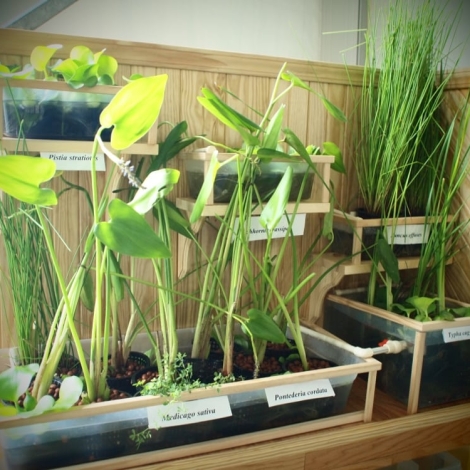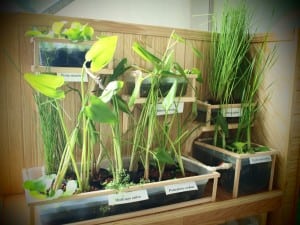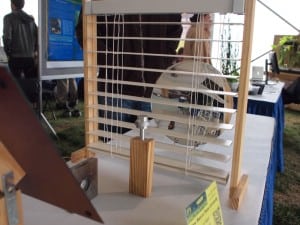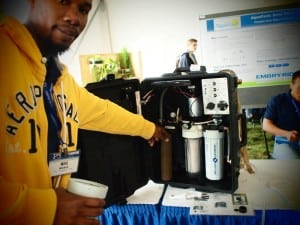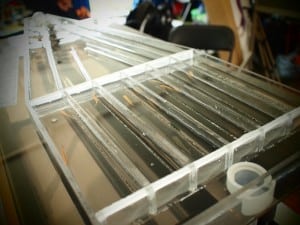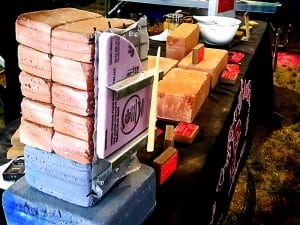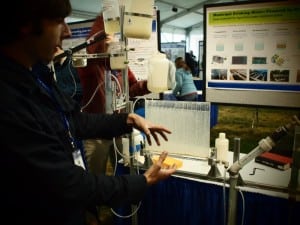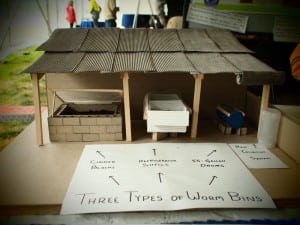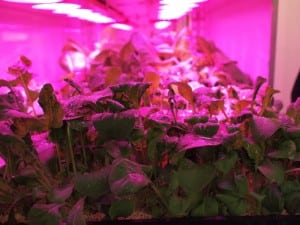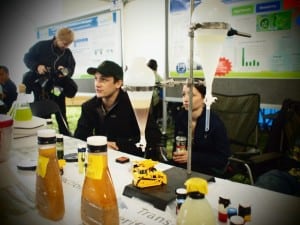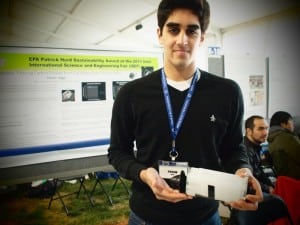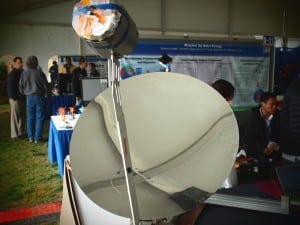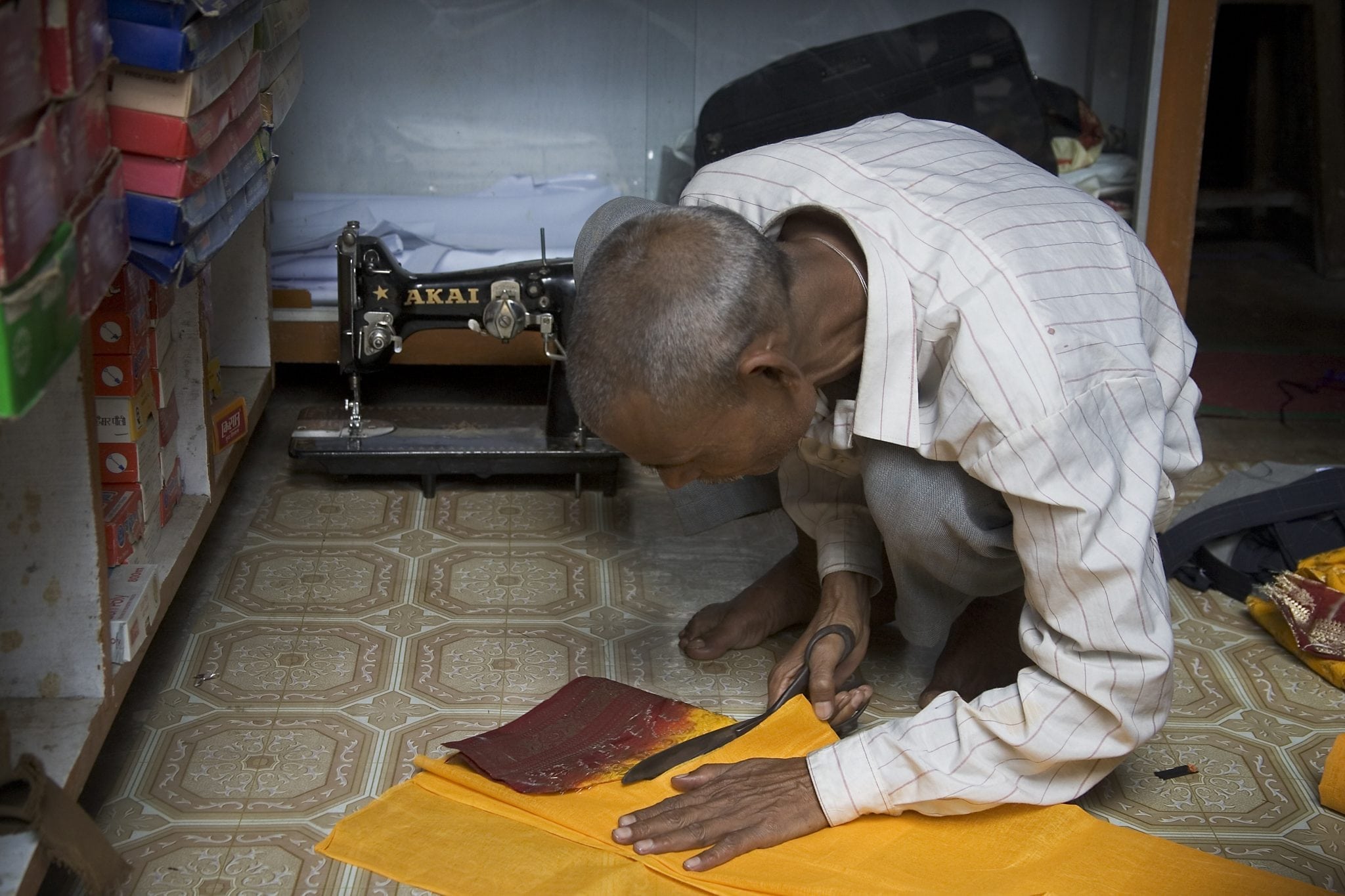A wetlands in a hair salon, a solar water purifier in a backpack and worm bins for trash clean-up were a few of the innovations that caught our attention at the eighth annual National Design Expo on the National Mall in Washington, DC. For three rainy days during Earth Day weekend, 75 teams from businesses, non-profits, universities and even high schools displayed their innovations.
Through its P3 program—People, Prosperity, Planet—the US Environmental Protection Agency had awarded grants of $15,000 each to 45 university research teams to develop projects throughout the academic year. Once here, they competed for 15 grants of up to $90,000 to carry out studies or make working prototypes. These are a few of the new technologies that are cost-effective and have the potential to improve lives in resource-poor communities. [Check back here throughout the week as we update this roundup with more projects.]
A mini-wetlands for a hair salon
An indoor wetlands is on track to treat wastewater at a hair salon in Boone, North Carolina. A team from Appalachian State University in Boone has built a mini-wetland and plans to install it at a local salon called Haircut 101. The model is for three tiers of vegetation in a roughly 5′ x 5′ area that will strip contaminants from the salon’s graywater. Graywater is from sinks, floor drains and showers, but not from the toilet. Tests on the salon’s graywater show that wetland plants such as water lettuce and pickerel weed can remove residues of shampoo, conditioner and even hair dye in just a couple of days.
The goal is treat 350 gallons of graywater every 24 to 48 hours. It won’t be clean enough to drink, but the treated water will flush the salon’s toilets. That’s interesting, the researchers say, because, when you think about it, it takes a lot of energy to treat water until it’s fit for consumption, so it seems odd that we flush our toilets with drinking water. The research team won up to $90,000 from P3 to build their wetland water treatment facility in the salon.
Pyrolyzing algae with a solar furnace
Remember sizzling ants with a magnifying glass? New Mexico State University built the adult version of the same principle with its solar furnace. A 16- by 16-foot mirror reflects sunlight onto a solar concentrator, which is a parabolic mirror that is curved, like a magnifying glass, to focus sunlight into a small area. The concentrator directs radiation into a small chamber, heating it up to 3000F (1600C) in less than five minutes.
A research team at NMSU is building a heat-resistant device that holds algae in front of the solar heat wave to pyrolyze it—heat it to separate out useful gases and liquids like benzene and toluene, and it leaves char as a solid. This is an expo-friendly scale model of the furnace with a window between the reflector and the concentrator. The window regulates the solar radiation entering the pyrolyzer. Researchers are lavishing attention on algae as a potential replacement for some fossil fuels. There were several algal fuel projects on display at the design expo. But only this one had pyrotechnics.
Project abstract
Solar furnace on YouTube
Solar water purifier in a backpack
When a disaster blocks roads and hampers the movement of supplies, delivering clean water to the victims can be challening. It may be easier to provide water treatment rather than just water. And why not make it solar? A solar-powered pump and purifier in a backpack is the disaster management solution from a team at Embry-Riddle Aeronautical University in Daytona Beach, Florida. Their prototype has two foldable 75-watt solar panels, a 12-volt pump and a series of three filters that remove bacteria and sediment and improve the taste.
A solar-powered fishery
As the maxim goes, you can give a man a fish, but it’s better to give him a solar-powered fishery. With a P3 grant they won in 2010, a team at Roger Williams University in Bristol, Rhode Island has built a 9000-square-foot aquaculture pond with 15 fish pens (that take up less than 4 percent of the pond’s volume). The pond could produce an estimated 5000 pounds of largemouth bass.
To aerate the water and boost the growth of the fish, 18 24-volt solar panels charge batteries and power an airlift pump circulator. Next month, when the water warms, they plan to stock their pond with 3000 fingerlings and begin gathering data on their system.
Putting earthen construction to the test
Building homes with earthen blocks has clear economic advantages over using other materials. The blocks are little more than soil mixed with a small amount of cement or lime and compressed into shape. Not all dirt works, but dirt with the right amount of clay is cheap and widely available on construction sites worldwide. But fans of compressed-earth blocks say the benefits aren’t just financial. For example, earthen buildings regulate temperatures well, they say, and, built properly, they can be earthquake-resistant.
A team from the University of Oklahoma in Norman, Oklahoma, plans to test the claims by building an earthen home next to a previously built wood-framed house built to US National Green Building Standards. They’ll compare the two construction processes, the buildings’ structural integrity and they’ll outfit both with sensors to monitor heating and cooling efficiency. The researchers won second-round P3 grant for up to $90,000 for the project.
Our friend Jim Hallock, who teaches earthen-construction in San Antonio, Texas, and at his Instituto Tierra y Cal in San Miguel de Allende, Mexico, is advising the project. Hallock calls earthen blocks the building material of the future, a view shared by editors at Smithsonian Magazine who gave earthen buildings the first slot in their list of 40 things you need to know about the next 40 years.
The photo shows a model of the Oklahoma team’s blocks stacked side-by-side as an outer load-bearing wall with a layer of insulation.
Free plans: A no-power-necessary water treatment plant
In dirty water, a material that acts as a coagulant can glom onto the suspended particles, weigh them down and sink them to the bottom. To work, however, the coagulant needs to mix and collide with the contaminants. AquaClara, a research team at Cornell University in Ithaca, New York, designed a water treatment plant that puts this principle to work.
The coagulant, a widely available compound called poly-aluminum chloride, has time to collide with suspended particles as the water snakes back and forth in a cement channel shaped like the lines in front of airport security. After most of the particles have settled out, the water is filtered through sand and then chlorinated to kill any remaining pathogens and protect against re-contamination.
The plant is gravity-driven and electricity free, and it can be scaled up or down depending on the size of the community. Its estimated cost is $12,000 per liter treated per second. Maintenance costs as little as $3 per month for each household. AquaClara has built eight plants in Honduras, and in 2010 it won a P3 grant to develop an automatic chemical dose controller. The controller adjust the coagulant dosage according to the incoming volume of water, which can change with the weather.
AquaClara’s designs are open source and plans for the plant freely available online. Their Web site will email you a draft according to the specifications that you enter.
Worms taking out the trash in the Dominican Republic
California red worms munch organic waste in an informal settlement in Santo Domingo in the Dominican Republic. With assistance from a team at the University of Texas in Austin, residents of the shanty town turned to vermi-composting to solve a garbage-collection problem.
With no municipal trash collection service, their streets and unpaved pathways between their homes were clogged with garbage. Now, each household delivers their food and other organic waste to community composting bins. The worms convert the trash into fertilizer and the community sells it to local farmers.
The community has built three bins so far, one from cement blocks, another from a plastic 50-gallon drum and a third from a discarded refrigerator shell that had been stripped for parts. What’s left, the researchers say, is to figure out what to do with the inorganic waste. That’s their next challenge.
A farm in a shipping container
Instead of shipping fresh vegetables from the farm to the city, shipping the entire farm could be cheaper and more energy-efficient. SuperGrow shipping containers grow 1000 pounds of organic vegetables and herbs per month. The containers are packed with custom LED grow lighting and vertical racks of crops and soil. The process consumes less energy than growing crops on farms for cross-country shipment and in greenhouses, and it may even be more energy efficient than a local farm.
The energy savings are in location and lighting.
The proximity of the container to the veggie eaters is important – it’s right in their neighborhood, so transport costs are low. Also, the containers have higher yields and less loss than open-ground farms, and the produce is fresher, with a longer shelf life.
The lights are proprietary SuperGrow LEDs. The LEDs dim over time to avoid burning the plants as they grow toward the lights. Reflector film lines each grow rack to bathe the plants in light from all sides.
Studies show that veggies grown in greenhouses need many times more energy than food grown on open land. SuperGrow cites figures from the state of New York showing that produce grown in California and shipped to New York has an energy cost of 9 to 21 megajoules per kilogram. Counter-intuitively, greenhouse produce requires much more: 66 to 97 Mj/kg. And produce grown on a local farm (not shipped) requires five to 10 Mj/kg. With less waste and faster growth, the SuperGrow team figures their containers are even more energy-efficient than local farms.
The system is user friendly and off-grid capable. A container manager with an iPad controls the lighting, temperature and other environmental controls. And with a full tank of gas, the farm can grow food off-the-grid for a month.
SuperGrow is a brand name by the company Sustainable Essentials Enterprises. See them online for more information.
An algal upgrade for a landfill power plant
Algae is an important crop for biofuel production, but it doesn’t grow well in the cold of an upstate New York winter. There is an untapped heat source the algae could use to weather the winter, however: a landfill gas-to-energy plant. These power plants burn the methane gas released from the landfill as the trash decomposes, using the energy to produce electricity.
A research team from Clarkson University in Potsdam, New York, plans to grow algae in the comfort of waste heat from the plant at the Development Authority of the North Country landfill in Rodman, New York. The waste heat can protect the algae from the cold, and the landfill can provide nutrients. The algae can snack on rainwater runoff from the decomposing garbage, called leachate.
Biofuel from the algae could replace 20 percent of the diesel fuel that the plant uses now, the researchers estimate. Their work received an honorable mention at the expo.
An algae greenhouse to reduce tailpipe emissions
The movie line, “So crazy it just might work,” seems apropos to this idea: Why not tack a mini-greenhouse onto the end of a tailpipe to reduce carbon dioxide emissions! In this case, the whimsy has already had a real-world debut and it passed, sort of. Param Jaggi, a student at Plano East Senior High School in Plano, Texas, attached his algae-filled cylinder a vehicle’s exhaust pipe and found that it decreased CO2 emissions by up to 92 percent in the lab.
Road trials, however, have not been as promising. Jaggi believes the jolting motion of real-world driving might be too hard on the algae. He is not out of ideas, of course. Jaggi bred a heat-resistant algae strain for his early tests and now he has plans for how to keep algae alive on the road. Future tests may also reveal how the device affects the vehicle’s performance, Jaggi says.
A solar “jet engine” power generator
A new solar thermal power generator employs the Brayton Cycle, the same mechanism behind the jet engine. In the Brayton Cycle, compressed air flows over a hot surface, rapidly expands and shoots through a fan.
The heat for this new power generator comes from a solar concentrator, a parabolic mirror that focuses sunlight onto a cylinder suspended in front of it. The concentrated sunlight heats the cylinder to 1700K. When the cylinder is hot enough, the device injects compressed air into it. The air rapidly expands as it comes into contact with the hot inner surface and it blows out forcefully, turning a turbine. Some of the power it generates cycles back to power the air compressor, and the rest is available for use.
The cylinder is made in part of silicone carbide, a good absorber of solar radiation, say the researchers from Santa Clara University in Santa Clara, California, who are developing the design.
With the added benefit of cogeneration, which uses the waste heat left over from the process, the device can be more efficient than similar-sized photovoltaic panels. It can scale up or down, and comes in at about half the size and two-thirds of the cost of solar panels of the same wattage, the researchers say.
An array of these generators could serve as a modular power plant that can grow by adding new pairs of cylinders and mirrors. The arrangement would be similar to SolarOne’s modular plant under construction in India now.
